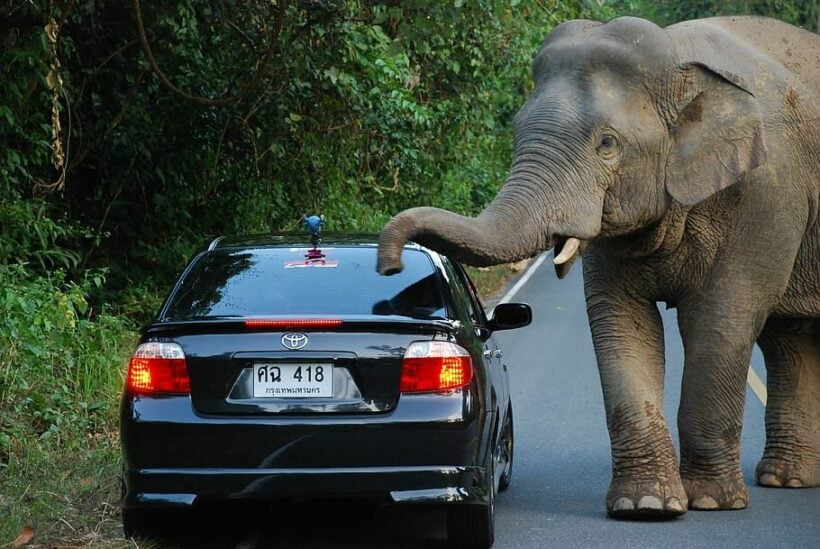Important rules and behaviours for driving in Thailand

Many expats who stay in Thailand, or even tourists, may wonder what rules and behaviours should be adhered to in driving safely across the Kingdom. As Thailand’s road rules are similar to other countries in Southeast Asia, one thing that sets Thailand apart is that its roads are generally quite good.
However, there are still rules, laws and behaviours that need to be followed. Here, we have a list of such things that can help drivers stay safe when cruising around the Kingdom.
The legal driving age
The legal age limit in Thailand in which to drive is 18 years old. And, in order to obtain a driving license in Thailand, potential drivers must take courses in a driving school before gaining a driving license.
Speed limits
On urban roads, the speed limit has been set at 50 kilometres per hour (km/h). For rural roads, it is set at 90 km/h. For motorbike users, the speed limit is generally set at 80 km/h, but be careful, you are not allowed on motorways and expressways. As traffic laws can change at any time, it is important to keep up to date with the speed limits set on the different types of roads in Thailand. Although going over these speeds is illegal, going under these speeds is recommended when encountering heavy traffic, rain, sand and other dangerous road conditions.
Traffic road signs to know
Thailand has five different types of road signs. It should not be hard to read them as they all feature the English language in addition to Thai. One example is the roundabout sign. This sign is circular in shape and features an arrow in a clockwise direction, meaning that it is illegal to change lanes. Drivers must also yield when necessary.
The warning signs in Thailand notify drivers of potential hazards in the area. Mandatory Signs mean you should adhere immediately to the posted rules. Information signs are most used by citizens, with many of them only being written in Thai language. Prohibitory Signs ban certain actions on the road. Priority Road Signs give the right away on specific sections of a highway.
Right of way
Speaking of right of way, Thai Traffic Laws state that when two moving vehicles reach a junction spot head-on, the car in the left lane is given the right of way. Unless there is a designation of a principle roadway mark, the vehicle on that mark has the right of way.
Overtaking law
Attempting to move ahead of another vehicle without a warning signal comes with fines of up to 1,000 baht. So, it is wise to avoid overtaking without having a valid reason. For example, when driving up steep slopes, going around curves, at junctions, during heavy rain, or when reaching a safety zone. If you do decide to overtake, use a signal. Remember, that the driving side is on the left in Thailand.
Honking is not for those experiencing road rage
Although it may seem that locals honk in certain situations, it is actually considered very rude to honk out of frustration. Any honking you may hear is likely due to cultural behaviours. A mere beeping sound is a way for locals to notify other drivers that they should give way for them to go ahead first (or flashing lights in some cases). It is a form of asking for permission from other drivers when you slightly beep your horn.
When approaching blind curves and narrow streets, drivers often honk just to notify other drivers that, they too, are on the road. Many drivers who aren’t used to the customs in Thailand will notice many cars honking their horns for no apparent reason. But, if you take a quick look around, you will see that horns are being pushed when driving near a temple. This is done to signify respect to the inhabitants of the temples, not to just make noise.

Switching lanes requires a turn or hand signal
In the event that you need to move over on a narrow road or switch lanes on a highway, using a turn signal or waving your hand is vital in preventing an accident. As Thailand is full of motorbikes, making a sudden lane switch could cause an accident if you aren’t aware of your surroundings.
Crosswalks should be recognised
Thailand has designated lanes for every type of vehicle. As the outdoor culture features many pedestrians, it is important to recognise the crosswalks. If you encounter a pedestrian lane in front of your car, stop first and allow any pedestrians to cross the road before moving forward. Although crosswalks are commonly featured in major cities, many people make their own, resulting in jaywalking.
Regardless if this is the correct way in which to cross a road, it is your responsibility as a driver to yield to pedestrians. Those with an international driving permit should always keep it with them in the event of someone failing to observe a crosswalk, resulting in an accident.
The rules of parking
When parking, make sure you park in a designated parking area. Make sure your car is in a safe place with security officers around. Also, there are additional rules that dictate when you can park. Such rules as not parking on even or odd days and no parking from 7 to 9am do exist, so be mindful, and look out for signs. Curbs marked red and white indicate a no parking zone at any time. Parking is also prohibited on entry and exit points of buildings, bus stop signs, and safety zones.
If you are unsure, a good rule of thumb is to ask yourself whether you are parking in a manner which obstructs traffic, if yes, then it’s best to search for a better spot to avoid fines or having your wheels clamped.

Seatbelt laws
As of 2022, all passengers in the vehicles are mandated to wear seatbelts at all times while travelling, even those in the back. Kids under 6 years old are legally required to use a child safety seat, while only being allowed to sit in the back seats of a car. The 2,000 baht fine is hefty, so be sure to keep your seatbelts fastened.
Drink-driving
In Thailand, the legal blood-alcohol concentration (BAC) limit for drivers over 20 years old is 0.05 grammes per litre of blood, generally equivalent to drinking one small can of beer. For those drivers with less than five years of driving experience, the limit is reduced to 0.02% unless they are okay with getting their permit seized by the officers who may cite them.
The fines here are also hefty, with fines ranging from 5,000 to 20,000 baht for your first offence, in addition to a possible six months imprisonment. Repeat offenders can find themselves up to 10 years behind bars, especially in cases resulting in serious injuries, or death upon others.
As with anywhere you go, it is important to keep a calm attitude and expression upon getting pulled over in Thailand. As the Land of Smiles is known for its people having a subdued attitude, getting upset and arguing will only cause you further problems. Safety is the number 1 reason to adhere to the rules and behaviours above, as it is important to observe the rules when driving in a foreign country.
Frequently Asked Questions (FAQs)
What are the required permits for tourists to drive in Thailand?
Tourists wishing to drive in Thailand must have an International Driving Permit (IDP) along with a valid national driver’s license. The IDP, valid in over 150 countries, translates your license into multiple languages and is often required by car rental companies in Thailand. To qualify, you must be at least 18 years of age. An IDP can be obtained before your trip through authorised entities by submitting a form, passport photos, and proof of payment.
Is it safe for foreigners to drive in Thailand?
Driving in Thailand can be challenging for foreigners due to unique road conditions and high accident rates, especially involving motorcycles. Speeding, reckless driving, and stray animals are common hazards. To drive safely, use signals, keep a safe distance, and be mindful of local driving habits and road conditions.
Can I turn left on a red light?
In Thailand, turning left on a red light is generally prohibited unless specific signs indicate otherwise. The sign “ซ้ายผ่านตลอด” (sai paan talort) means left turns are permitted at that intersection.
What to do if I get into an accident in Thailand?
Stay calm and do not leave the scene, as fleeing can result in imprisonment and void your insurance. Turn on your emergency lights, call your rental company or insurer for assistance. Contact the police at 191 or tourist police at 1155, and call an ambulance at 1554 if anyone is injured. Cooperate with the police without admitting fault and let your insurance provider handle the claim.
How strict are the helmet laws in Thailand?
In Thailand, helmet use is legally required for both motorcycle drivers and passengers, including tourists. While enforcement is stricter in urban areas like Bangkok, it is less rigorous in rural regions, leading to inconsistent compliance. Fines for non-compliance range from 500 to 1,000 baht, though enforcement varies.
Latest Thailand News
Follow The Thaiger on Google News:


























